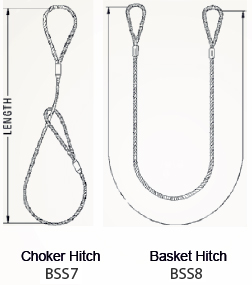IS:2762/82 IS:5245/1pt ||


| Min. Rope Size | Vertical Lift | Basket Lift | Choker Lift |
|---|---|---|---|
| mm | kg | kg | kg |
| 3 | 70 | 140 | 50 |
| 4 | 130 | 260 | 100 |
| 5 | 200 | 400 | 150 |
| 6 | 250 | 500 | 190 |
| 8 | 550 | 1100 | 410 |
| 9 | 670 | 1340 | 500 |
| 10 | 800 | 1600 | 600 |
| 11 | 1000 | 2000 | 750 |
| 12 | 1200 | 2400 | 900 |
| 13 | 1400 | 2800 | 1050 |
| 14 | 1750 | 3500 | 1300 |
| 16 | 2000 | 4000 | 1500 |
| 18 | 2500 | 5000 | 1875 |
| 19 | 3000 | 6000 | 2250 |
| 20 | 3300 | 6600 | 2250 |
| 22 | 4000 | 8000 | 3000 |
| 24 | 4600 | 9200 | 3450 |
| 25 | 5000 | 10000 | 3750 |
| 29 | 6500 | 13000 | 4875 |
| 32 | 8000 | 16000 | 6000 |
| 35 | 9200 | 18400 | 6900 |
| 36 | 10400 | 20800 | 7800 |
| 38 | 12000 | 24000 | 9000 |
| 40 | 12700 | 25400 | 9525 |
| 44 | 16700 | 33400 | 12525 |
| 48 | 20000 | 40000 | 15000 |
| 52 | 23000 | 46000 | 17250 |
Dos and Donts for steel wire rope slings
Here are some important dos and don’ts for using steel wire rope slings safely:
Dos:
- Check the weight of the load to be lifted.
- Inspect slings before use and discard any that are defective.
- Protect slings from sharp corners by using suitable packing materials like rubber or wood.
- Use protective gloves when handling steel wire rope slings.
- Store slings in a dry place when not in use.
Don’ts:
- Don’t exceed the stated SWL (Safe Working Load).
- Don’t use slings with kinking, crushing, birdcaging, or other damage that distorts the original rope construction.
- Don’t use slings with more than 10 randomly broken wires in one rope lay, or 5 wires in one strand in one rope lay.
- Don’t use slings with severe wear, abrasion, or scraping.
- Don’t bend slings over corners.
- Don’t exceed 120 degrees when using multi-legged wire rope slings.
- Don’t drag slings along the floor.
- Never allow the load to be carried over the heads of other people.
- Never ride on the load.
- Never join slings by knotting, always use a shackle.
- Never shorten slings by knotting.
Following these guidelines will help ensure safe and effective use of steel wire rope slings.

